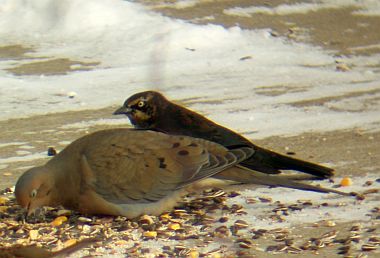They’re the poster child for bird decline. So many have gone missing their pictures should be on milk cartons.
Have you seen me? I’m talking about the dark bird in this picture. The rusty blackbird.
Rusty blackbirds have declined 85-99% in the past 40 years. No one is sure how this happened or even how many are left but for the next nine days you can help find out.
From February 7 to 15, Cornell Laboratory of Ornithology, National Audubon Society, the PA Game Commission and the Rusty Blackbird Technical Working Group have teamed up to sponsor a Rusty Blackbird Blitz to find and document the location and concentration of rusty blackbirds on their wintering grounds.
Rusty’s are a wetland species that breeds in the boreal forest of Canada and winters in wooded wetlands from the Rust Belt to the Gulf Coast, from Oklahoma to the Atlantic. Pennsylvania is on the northern edge of the rusty blackbirds’ winter range so we can play a part.
All you have to do is look for rusty blackbirds and submit your observations online at e-Bird. There are no complicated time or location restrictions. Look for rusty’s in wooded wetlands, swamps and pond edges wherever, whenever and as often as you like. Then let e-Bird know where you found them.
For clues on how to identify them, click here or on the picture.
And good luck!
(A lone rusty blackbird has visited Marcy Cunkelman’s yard in Indiana County for two winters in a row. He’s being coy in this picture, partially hidden behind a mourning dove. Photo by Marcy Cunkelman.)

A timely and important article, Kate–thank you. They are a pretty bird, I think. We (Todd Bird Club) saw quite a few at Yellow Creek last October and I saw a small flock at Crooked Creek in November 08. It was great to see them, and sad that such an interesting bird is on the decline. They do kind of blend in with the red-wings and other birds sometimes, too. Marcy has a wealth of “yardbirds”, too, doesn’t she? And well deserved considering how much work she and Dan put into their wonderful “habitat”…